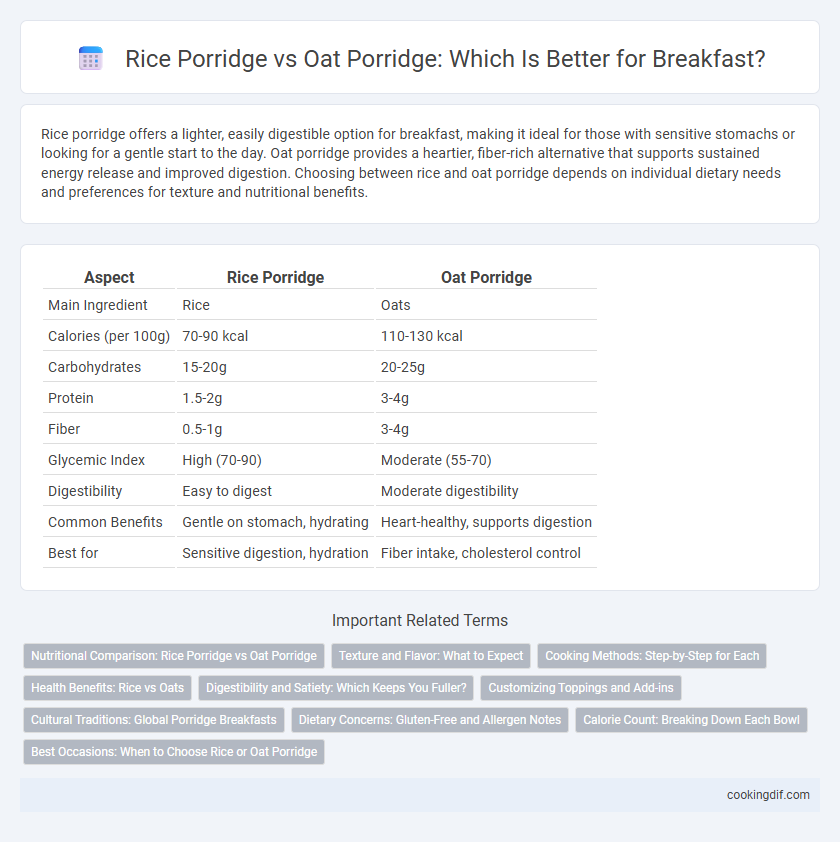Rice porridge offers a lighter, easily digestible option for breakfast, making it ideal for those with sensitive stomachs or looking for a gentle start to the day. Oat porridge provides a heartier, fiber-rich alternative that supports sustained energy release and improved digestion. Choosing between rice and oat porridge depends on individual dietary needs and preferences for texture and nutritional benefits.
Table of Comparison
| Aspect | Rice Porridge | Oat Porridge |
|---|---|---|
| Main Ingredient | Rice | Oats |
| Calories (per 100g) | 70-90 kcal | 110-130 kcal |
| Carbohydrates | 15-20g | 20-25g |
| Protein | 1.5-2g | 3-4g |
| Fiber | 0.5-1g | 3-4g |
| Glycemic Index | High (70-90) | Moderate (55-70) |
| Digestibility | Easy to digest | Moderate digestibility |
| Common Benefits | Gentle on stomach, hydrating | Heart-healthy, supports digestion |
| Best for | Sensitive digestion, hydration | Fiber intake, cholesterol control |
Nutritional Comparison: Rice Porridge vs Oat Porridge
Rice porridge offers a low-fat, easy-to-digest option rich in carbohydrates and suitable for gluten-sensitive individuals, while oat porridge provides higher protein, fiber, and essential minerals like magnesium and iron that support heart health and digestion. Oats contain beta-glucan, a soluble fiber that helps lower cholesterol levels, making it more beneficial for cardiovascular wellness compared to rice porridge's primarily starchy composition. Though both serve as energy-boosting breakfasts, oat porridge delivers a more balanced nutrient profile, supporting sustained satiety and metabolic health.
Texture and Flavor: What to Expect
Rice porridge offers a smooth, creamy texture with a mildly sweet and neutral flavor, making it a comforting choice for breakfast. Oat porridge has a thicker, heartier texture with a slightly nutty and earthy taste that provides more depth and chewiness. Choosing between the two depends on whether you prefer a delicate, gentle mouthfeel or a robust, satisfying bite to start your day.
Cooking Methods: Step-by-Step for Each
Rice porridge requires simmering rice in a large amount of water or broth for 1 to 2 hours until grains break down into a creamy consistency, often involving occasional stirring to prevent sticking. Oat porridge is typically prepared by boiling oats in water or milk for 5 to 10 minutes, stirring continuously for a smooth texture and quicker cooking time. Both methods emphasize gradual heat application and liquid absorption to achieve the ideal porridge texture, but rice porridge demands a longer cooking duration and more frequent attention.
Health Benefits: Rice vs Oats
Rice porridge offers a gluten-free option rich in easily digestible carbohydrates, making it suitable for sensitive stomachs and providing steady energy release. Oat porridge contains high levels of soluble fiber, particularly beta-glucan, which supports heart health by lowering cholesterol and promotes satiety for weight management. Both porridges provide essential nutrients, but oats deliver a higher protein content and beneficial antioxidants, enhancing overall nutritional value.
Digestibility and Satiety: Which Keeps You Fuller?
Rice porridge offers a light, easily digestible option ideal for sensitive stomachs, while oat porridge contains higher fiber content that promotes longer satiety. The beta-glucan in oats slows digestion, helping maintain fullness and stabilize blood sugar levels more effectively than rice porridge. For a breakfast that keeps hunger at bay, oat porridge is generally preferred, though rice porridge suits those needing gentle digestion.
Customizing Toppings and Add-ins
Rice porridge offers a neutral base ideal for savory toppings like scallions, soy sauce, or pickled vegetables, enhancing umami flavors, whereas oat porridge pairs well with sweet additions such as fresh berries, nuts, and honey, providing a hearty and naturally sweeter profile. Customizing rice porridge with ginger, century eggs, or shredded chicken creates a warm, comforting breakfast rich in texture and depth, while oat porridge can be enriched with cinnamon, chia seeds, or almond butter for added nutrition and taste complexity. Both porridges can be tailored to individual preferences, maximizing nutritional benefits and flavor diversity through carefully chosen toppings and mix-ins.
Cultural Traditions: Global Porridge Breakfasts
Rice porridge, known as congee in many Asian cultures, serves as a staple breakfast offering with a smooth texture and savory accompaniments such as pickled vegetables and salted eggs. Oat porridge, popular in Western countries, emphasizes a creamy consistency often enhanced with fruits, nuts, and sweeteners reflecting a preference for hearty and nutritious morning meals. Both rice and oat porridges demonstrate how breakfast traditions adapt to regional agricultural resources and cultural tastes worldwide.
Dietary Concerns: Gluten-Free and Allergen Notes
Rice porridge is naturally gluten-free, making it an ideal breakfast option for individuals with celiac disease or gluten sensitivities, whereas traditional oat porridge may contain gluten due to cross-contamination unless certified gluten-free oats are used. Both rice and oat porridges are generally low in common allergens, but oats can cause reactions in some people with oat-specific allergies or avenin sensitivity. Choosing rice porridge helps avoid gluten and potential oat allergens, supporting those with strict dietary restrictions and food intolerances.
Calorie Count: Breaking Down Each Bowl
Rice porridge typically contains around 150 calories per cup, making it a lighter breakfast option compared to oat porridge, which averages 200 calories per cup due to its higher fiber and protein content. Oat porridge provides sustained energy release and greater satiety, beneficial for prolonged morning activity. Choosing between rice and oat porridge depends on individual calorie needs and nutritional goals, with rice porridge favoring low-calorie diets and oat porridge supporting muscle maintenance and digestion.
Best Occasions: When to Choose Rice or Oat Porridge
Rice porridge suits light, easily digestible breakfasts, making it ideal for mornings when a gentle start is needed, such as after illness or a heavy meal the night before. Oat porridge provides sustained energy and higher fiber, perfect for active days or workouts requiring long-lasting fuel. Choosing between rice and oat porridge depends on the desired digestion rate and energy release tailored to specific morning routines.
Rice porridge vs oat porridge for breakfast Infographic

 cookingdif.com
cookingdif.com